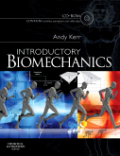
An interactive text ideal for all health and sports professional students whorequire a basic understanding of the major biomechanical principles they meetin practice, including movement analysis and tissue mechanics. Starting from the point of zero-knowledge, this book presents what can be a very dry and difficult area, in an engaging and visual way using everyday objects to illustrate the principles and linking this to human anatomy and movement . Less time isspent on mathematics and classic mechanics with greater emphasis on how theseprinciples are applied to professional practice Introductory Biomechanics uses workbook-style learning diffusing manageable chunks of theory with learning activities and ultimately making the link back to clinical application. The accompanying CD is closely tied in with the text, containing video clips and real motion analysis data of walking, jumping, cycling and rising from a chair. There are also numerous animations of principles in action. The user is in control of most clips and animations and can change settings and manipulate variables practically showing biomechanics in action. The CD also contains a dynamicquiz drawing randomly from a pool of over 70 questions (MCQs, fill-in-the-blanks, true/false) which also provides feedback and percentage score on completion. INDICE: IntroductionChapter 1 Fundamentals of forceWhat is force?What doesmechanical force doScalar or Vector?Drawing vectorsPoint of applicationForce magnitude and change in motionThe force of musclesMagnitude of momentsDirection of moments Chapter 2 Gravity, mass and stability Gravity: the ultimate forceCentre of mass Calculating the centre of mass. Moments created by mass Stability Local and general stability Standing balance Chapter 3 Force analysis: graphs and mathsHow do forces combine? The Q-angle and knee pain Measuring force Using mathematics to resolve force Chapter 4 Forces and motion InertiaMoment of inertia Linear momentum Rotational momentum Newton's second law: Impulse andmomentum Newton's Third law: Action and reactionBodies in contact: pressure and frictionCentre of pressureFrictionChapter 5 Work and machines Work Muscles at work Direction of work Using machines to do work Categories of levers Velocity ratioMore advanced machinesPulleys Pulleys in the human body The Power of workEfficiencyPractical problems on force and human movementChapter 6 Stress and strainDefinitionsStressStrainStress strain relationshipA few other properties of materialsChapter 7 Composition and mechanical properties of connective tissueWhat connective tissue is.SkinMuscle BoneArticular cartilageTissue remodelling Inactivity (immobilisation)MaturationEffect of ageingEffect of recent history TemperatureScience of stretchChapter 8 FlowRelative densityHydrostatic pressure Archimedes principle, buoyancy and Pascals lawTake the pressure offAirpressureMechanics of flow Drag Bernoulli's principle Blood flow: Haemodynamics Chapter 9 Energy and movementWhat energy isPotential and kinetic energyElastically stored potential energyEnergy conservation during movementMeasuring energy during movement Chapter 10 Therapeutic application of forceMobilisation techniquesStatic stretchingRespiratory techniquesOrthosesDynamic wrist splints
- ISBN: 978-0-443-06944-4
- Editorial: Churchill Livingstone
- Encuadernacion: Rústica
- Páginas: 150
- Fecha Publicación: 21/01/2010
- Nº Volúmenes: 1
- Idioma: Inglés
